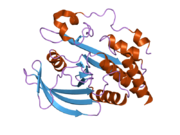Tyrosine-protein phosphatase non-receptor type 3 is an enzyme that in humans is encoded by the PTPN3 gene.[5][6]
Function[edit]
The protein encoded by this gene is a member of the protein tyrosine phosphatase (PTP) family. PTPs are known to be signaling molecules that regulate a variety of cellular processes including cell growth, differentiation, mitotic cycle, and oncogenic transformation. This protein contains a C-terminal PTP domain and an N-terminal domain homologous to the band 4.1 superfamily of cytoskeletal-associated proteins. P97, a cell cycle regulator involved in a variety of membrane related functions, has been shown to be a substrate of this PTP. This PTP was also found to interact with, and be regulated by adaptor protein 14-3-3 beta.[6]
Interactions[edit]
PTPN3 has been shown to interact with YWHAB.[7]
References[edit]
- ^ a b c GRCh38: Ensembl release 89: ENSG00000070159 – Ensembl, May 2017
- ^ a b c GRCm38: Ensembl release 89: ENSMUSG00000038764 – Ensembl, May 2017
- ^ "Human PubMed Reference:". National Center for Biotechnology Information, U.S. National Library of Medicine.
- ^ "Mouse PubMed Reference:". National Center for Biotechnology Information, U.S. National Library of Medicine.
- ^ Yang Q, Tonks NK (August 1991). "Isolation of a cDNA clone encoding a human protein-tyrosine phosphatase with homology to the cytoskeletal-associated proteins band 4.1, ezrin, and talin". Proc Natl Acad Sci USA. 88 (14): 5949–53. Bibcode:1991PNAS...88.5949Y. doi:10.1073/pnas.88.14.5949. PMC 51999. PMID 1648725.
- ^ a b "Entrez Gene: PTPN3 protein tyrosine phosphatase, non-receptor type 3".
- ^ Zhang SH, Kobayashi R, Graves PR, Piwnica-Worms H, Tonks NK (October 1997). "Serine phosphorylation-dependent association of the band 4.1-related protein-tyrosine phosphatase PTPH1 with 14-3-3beta protein". J. Biol. Chem. 272 (43): 27281–7. doi:10.1074/jbc.272.43.27281. PMID 9341175.
Further reading[edit]
- Arimura Y, Hinoda Y, Itoh F, Takekawa M, Tsujisaki M, Adachi M, Imai K, Yachi A (1992). "cDNA cloning of new protein tyrosine phosphatases in the human colon". Tumour Biol. 13 (3): 180–6. doi:10.1159/000217763. PMID 1626183.
- Ikuta S, Itoh F, Hinoda Y, Toyota M, Makiguchi Y, Imai K, Yachi A (1995). "Expression of cytoskeletal-associated protein tyrosine phosphatase PTPH1 mRNA in human hepatocellular carcinoma". J. Gastroenterol. 29 (6): 727–32. doi:10.1007/BF02349278. PMID 7874267. S2CID 31617297.
- Itoh F, Ikuta S, Hinoda Y, Arimura Y, Ohe M, Adachi M, Ariyama T, Inazawa J, Imai K, Yachi A (1994). "Expression and chromosomal assignment of PTPH1 gene encoding a cytosolic protein tyrosine phosphatase homologous to cytoskeletal-associated proteins". Int. J. Cancer. 55 (6): 947–51. doi:10.1002/ijc.2910550612. PMID 8253532. S2CID 32380202.
- Zhang SH, Kobayashi R, Graves PR, Piwnica-Worms H, Tonks NK (1997). "Serine phosphorylation-dependent association of the band 4.1-related protein-tyrosine phosphatase PTPH1 with 14-3-3beta protein". J. Biol. Chem. 272 (43): 27281–7. doi:10.1074/jbc.272.43.27281. PMID 9341175.
- Zhang SH, Liu J, Kobayashi R, Tonks NK (1999). "Identification of the cell cycle regulator VCP (p97/CDC48) as a substrate of the band 4.1-related protein-tyrosine phosphatase PTPH1". J. Biol. Chem. 274 (25): 17806–12. doi:10.1074/jbc.274.25.17806. PMID 10364224.
- Gjörloff-Wingren A, Saxena M, Han S, Wang X, Alonso A, Renedo M, Oh P, Williams S, Schnitzer J, Mustelin T (2000). "Subcellular localization of intracellular protein tyrosine phosphatases in T cells". Eur. J. Immunol. 30 (8): 2412–21. doi:10.1002/1521-4141(2000)30:8<2412::AID-IMMU2412>3.0.CO;2-J. PMID 10940933. S2CID 8132613.
- Zheng Y, Schlondorff J, Blobel CP (2003). "Evidence for regulation of the tumor necrosis factor alpha-convertase (TACE) by protein-tyrosine phosphatase PTPH1". J. Biol. Chem. 277 (45): 42463–70. doi:10.1074/jbc.M207459200. PMID 12207026.
- Sozio MS, Mathis MA, Young JA, Wälchli S, Pitcher LA, Wrage PC, Bartók B, Campbell A, Watts JD, Aebersold R, Hooft van Huijsduijnen R, van Oers NS (2004). "PTPH1 is a predominant protein-tyrosine phosphatase capable of interacting with and dephosphorylating the T cell receptor zeta subunit". J. Biol. Chem. 279 (9): 7760–9. doi:10.1074/jbc.M309994200. PMID 14672952.
- Blanchetot C, Chagnon M, Dubé N, Hallé M, Tremblay ML (2005). "Substrate-trapping techniques in the identification of cellular PTP targets". Methods. 35 (1): 44–53. doi:10.1016/j.ymeth.2004.07.007. PMID 15588985.
- Benzinger A, Muster N, Koch HB, Yates JR, Hermeking H (2005). "Targeted proteomic analysis of 14-3-3 sigma, a p53 effector commonly silenced in cancer". Mol. Cell. Proteomics. 4 (6): 785–95. doi:10.1074/mcp.M500021-MCP200. PMID 15778465.
- Jespersen T, Gavillet B, van Bemmelen MX, Cordonier S, Thomas MA, Staub O, Abriel H (2006). "Cardiac sodium channel Na(v)1.5 interacts with and is regulated by the protein tyrosine phosphatase PTPH1". Biochem. Biophys. Res. Commun. 348 (4): 1455–62. doi:10.1016/j.bbrc.2006.08.014. PMID 16930557.
- Jing M, Bohl J, Brimer N, Kinter M, Vande Pol SB (2007). "Degradation of tyrosine phosphatase PTPN3 (PTPH1) by association with oncogenic human papillomavirus E6 proteins". J. Virol. 81 (5): 2231–9. doi:10.1128/JVI.01979-06. PMC 1865939. PMID 17166906.
- Töpffer S, Müller-Schiffmann A, Matentzoglu K, Scheffner M, Steger G (2007). "Protein tyrosine phosphatase H1 is a target of the E6 oncoprotein of high-risk genital human papillomaviruses". J. Gen. Virol. 88 (Pt 11): 2956–65. doi:10.1099/vir.0.83123-0. PMID 17947517.







Well, that’s interesting to know that Psilotum nudum are known as whisk ferns. Psilotum nudum is the commoner species of the two. While the P. flaccidum is a rare species and is found in the tropical islands. Both the species are usually epiphytic in habit and grow upon tree ferns. These species may also be terrestrial and grow in humus or in the crevices of the rocks.
View the detailed Guide of Psilotum nudum: Detailed Study Of Psilotum Nudum (Whisk Fern), Classification, Anatomy, Reproduction